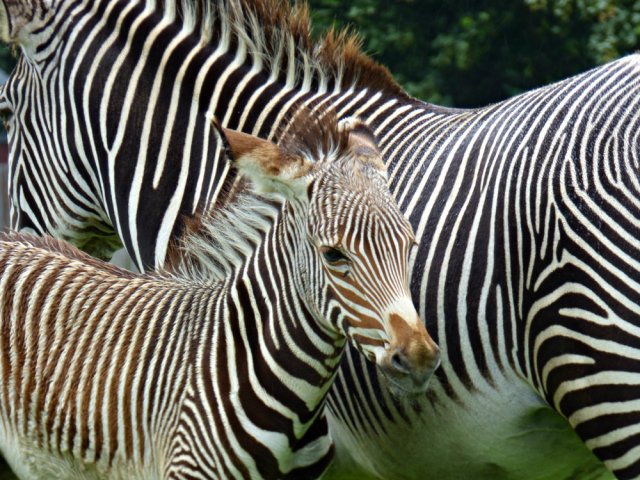
In a complete role reversal, my son took me to the zoo today. I have very mixed feelings about zoos in general. The thought of confining animals designed for vast landscapes has always seemed wrong and there are truly horror stories of the conditions in which many animals have been imprisoned. On the other hand, modern zoos do a huge amount to aid the preservation of wildlife these days and, with captive breeding programmes, monitoring and study, are able to make a substantial contribution to the conservation of endangered species and habitats. And then there is the emotive argument… unless we can see, smell… ‘feel’… the beauty of these animals… why would we learn to care about what happens to them at all?

We went to Whipsnade, not very far from where we now live and, oddly enough, a place I visited several times as a child. My father was stationed in the south, much of my family was in the north and even then, the road between was familiar. I have seen the zoo evolve over the decades.
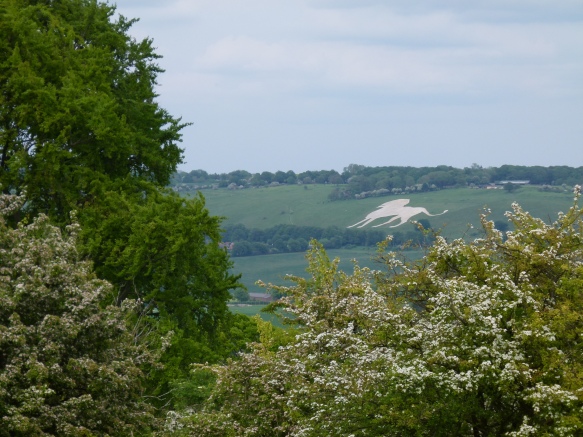
I remember the lions’ den as it was back then. It used to be just above the great lion carved into the chalk of the hillside; a small, round enclosure with a deep ditch and high bars. The lions had nowhere to run, no space to play, no way to be lions. It hurt to see them there, even then, even with the childhood wonder of seeing real lions. It was a far cry from the cavies and wallabies that wander the park at will or the prairie dogs that colonised Bison Hill.
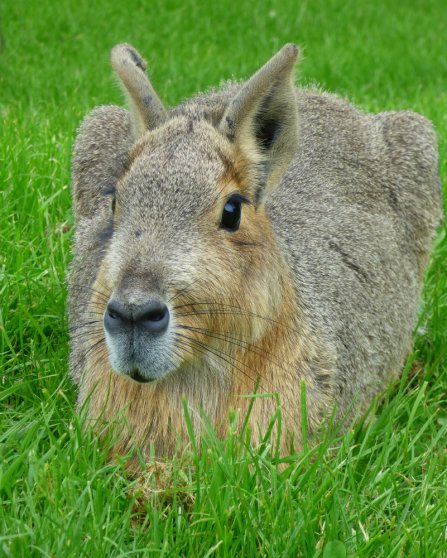
I went there too in my late teens with my husband and by the time I took my own children there, years later, the paddocks were considerably larger, but still many of the animals seemed to interact with visitors largely because there was little else to do.
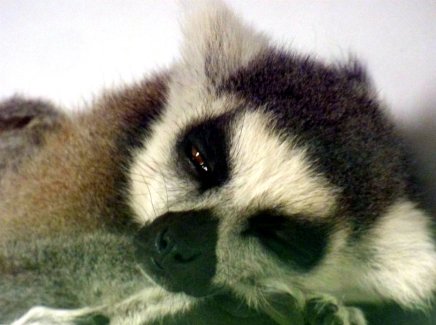
Today was different. The paddocks are huge… still not a wild plain or jungle, but open and full of things to do. The animals paid little attention to the visitors… those that were not hiding from the rain were too busy finding food. The chimpanzees were a case in point. I well remember the sad faces that looked out with a bored hopelessness or shrieked at the gawping crowds with eyes like our own. Today they were foraging, working for their food by finding it themselves and completely absorbed by the task. It was possible to watch them be chimpanzees not exhibits.
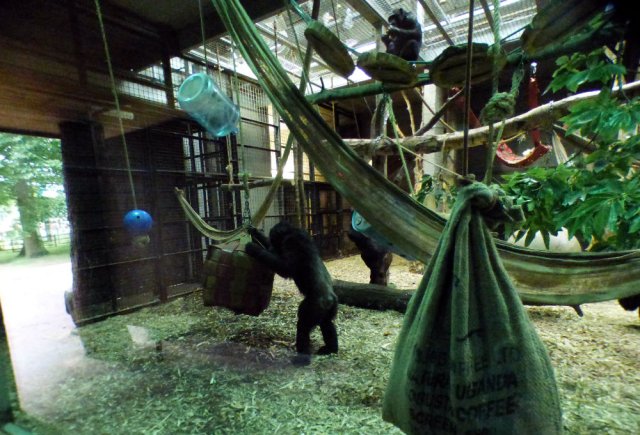
No zoo is perfect, no captivity is ‘right’… but mankind has devastated many species to the point of extinction and beyond, to a point of no return. Scientists estimate that up to 200 species of plant, insect, bird and mammal become extinct every single day. The major zoos, like Whipsnade, are all involved in conservation and their role is now an important one. Some species, like the northern white rhino, of which only three are left in the world, survive only in captivity and, if we are to attempt to redress at least some of the damage we have done, it may be that the wildlife parks and zoos have an important role to play… and the wealth of young animals was some indication of that.
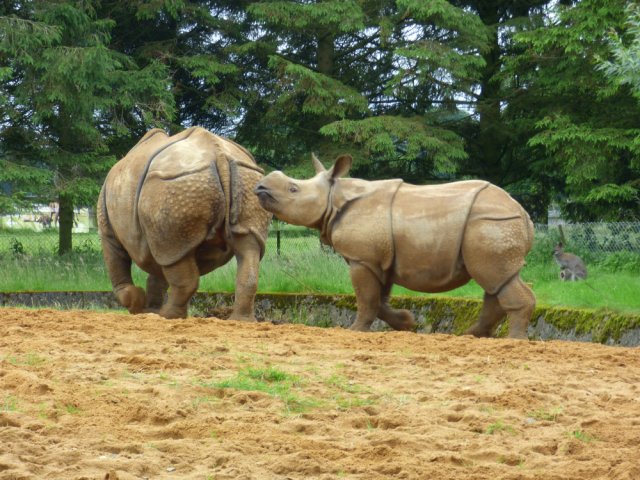
Today, we took the cameras.. mine, already damaged beyond repair and limited was further hampered by the weather… and the weather was vile. Half the animals, very sensibly, refused to come out of their enclosures, but amid the exotic and beautiful, local wildlife also thrives in what has become a safe-haven with a plentiful food supply. I missed the shot of the great spotted woodpecker as my camera would only focus on the teeming rain. There were other birds though. “You’re obsessed,” complained my son as, drenched and mud-spattered, I ignored the cheetahs and chased yet another shot of the kites. And why not? These are wild creatures after all… a success story of conservation and reintroduction of a species close to extinction…not captives of man’s mistakes.
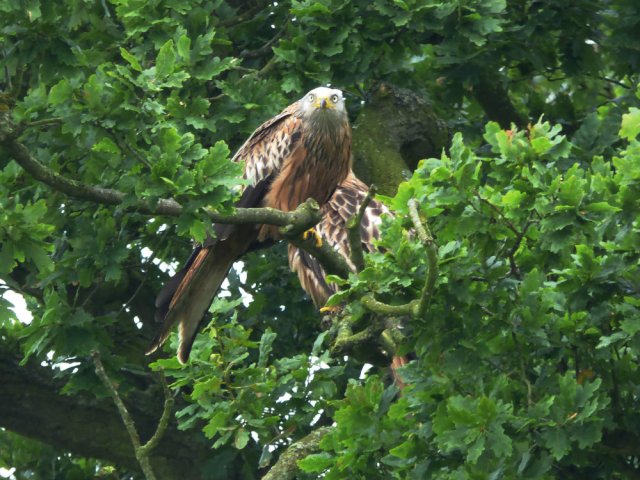









































I love zebras!
LikeLiked by 1 person
There were two foals, both gorgeous, though this one was the most confident. The other didn’t quite know what to do with legs yet 🙂
LikeLiked by 1 person
hehe I love that their stripes go up through their manes too.
LikeLike
They don’t look possible, do they? 🙂
LikeLiked by 1 person
🙂
LikeLiked by 1 person
Sue, I like how you “weighed” out the positives and negatives of captive animals in Zoo’s. I agree we have come a long way in creating a more interactive and more natural environment. Since most of my own friends may never go on a safari, it is a great opportunity to visit a local zoo. Hugs, Robin 🙂
LikeLike
They are the best chance for many people to see live animals, unfortunately and learn about them. And learn to care.
LikeLike
But I also don’t like zoos. I do understand the need for bringing awareness to people but I always feel so sorry for the animals. :(. Sorry for the two comments. I accidentally pressed send on the first one via my phone.
LikeLike
If you have to have zoos, Whipsnade is vast and about as well done as possible, with constant improvements focused on the animals’ welfare.
LikeLiked by 1 person
Vast is good…. Everyone always says the San Diego zoo is so good but when I went there I still saw cages and pens. I think people say it’s good because they have a lot of animals. 😦
LikeLike
I overheard some of the keepers talking about the San Diego zoo while I was there. Apparently the standards of care are high, but that doesn’t mean there is enough space.
LikeLiked by 1 person
Good to know the care is high…I did notice that it was pristine and the animals looked healthy but you’re right…not enough space. I’m thrilled that Sea World will not be having anymore Orcas. That used to drive me bonkers!!
LikeLike
The pools were the one area that seemed way too small at Whipsnade, though I know there is an ongoing commitment to replace the older buildings and pens and this muct be one of the last.
LikeLiked by 1 person
I had to google this zoo as I’d not heard of it.
LikeLike
It is part of the London Zoo set-up, and both heavily involved in conservation projects.
LikeLiked by 1 person
I love the zoo. And what great pictures. Thank you for sharing.
LikeLike
I’ll doubtless be sharing a few more 🙂
LikeLiked by 1 person
Your site won’t let me comment. Let’s see if this goes through.
LikeLike
Okay, I guess I’m okay now. Just wanted to say I remember Whipsnade from my visit there in the late 1970s. It was Gerald Durrell’s first zoo, before he got his own on Jersey. Ambivalence aside, zoos are the last, best hope for many species.
LikeLike
I was there in the 60s, then 70s and 90s… the evolution of the place is striking.
LikeLike
I’ve never been to Whipsnade, but visited many zoos over the years, as a child and with school trips. It is good to see how they have evolved, becoming more animal friendly, but of course they will never be ‘reality’ for these animals. I also have mixed views though. Much as I love being able to see the animals, and exposing my children to creatures they may never see in the wild, I do feel for the ones in enclosures that are small, and not designed with the animals in mind.
The zoo in Helsinki I had mixed feelings about, as it is on an island, so there is not much space but a vast array of wild animals… Sonsome enclosures didn’t seem to be big enough…
Your photos, the ones you managed to take, were still magnificent though Sue!!!
LikeLike
I’ll be sharing a few more photos… I managed one or two more 😉
I know what you mean, Ritu. The Paris zoo always felt like a himan ‘attraction’ rather than a place to keep animals. Many of them were built before we learned better, but that doesn’t excuse the wilful ignorance that saw animals as chattels and exhibits. I recommend Whipsnade if you get the chance. You need a whole day… and then don’t really get chance to see everything as it covers 600 acres.
LikeLiked by 1 person
One day..,! I loved Howletts too. The enclosures there are vast, and I do love to see the elephants!!!
LikeLike
Whipsnade are in th middle of building a new complex for the elephants…and we didn’t get that far. We did see them out for a walk though, holding each other trunk and tail with the babies 🙂
LikeLiked by 1 person
The babies are sooo cute!!!
LikeLike
They are… but even the baby rhino was too and they are not the prettiest animals 🙂
LikeLiked by 1 person
All babies are gorgeous. .. honestly!!!
LikeLike
I’m inclined to agree 🙂
LikeLiked by 1 person
I remember visiting the zoo as I child. Like you, I have mixed feelings about them too. It is wonderful though to see the animals up close and learn more about them. Although, I have to say I was terrified when some of the animals got a little too close to the care when we went to Knowsley Safari park! 🙂
LikeLike
I’ll never forget a horse that stuck its hed in through the car window. You realise how big they are then 🙂
LikeLiked by 1 person
Yes, You certainly do! 🙂
LikeLiked by 1 person
🙂
LikeLike
Reblogged this on firefly465.
LikeLike
Thank you Adele 🙂
LikeLiked by 1 person
It’s years since I’ve been to a zoo – haven’t even managed to go to Edinburgh Zoo to see the famous pandas.
Love your zebra photo. What happened to damage your camera? I’ve been meaning to ask what it is you use. I remember you wrote a post about it and I thought it sounded like the kind of camera my sister would like.
LikeLike
I have the Panasonic Lumix DMC – FZ72. It’s a bridge camera with a lot of features if you want them, but great as a point and shoot. The 60x optical zoom is amazing. The previous Lumix (FZ200) had a Leica lens and took a better quality image, but with 24x optical zoom. Stuart uses that one now.
They have both been dropped, dunked, fallen upon and generally battered… and still work. Mine now has problems after one fall too many and is limited in what it will do, but still functions if I work within what it is happy with. Nick has a pocket Lumix and that takes amazing pictures too… I’d thoroughly recommend the range.
LikeLiked by 1 person
Thanks for the camera info, Sue. I’ve written it down this time. I’m so useless as a photographer it wouldn’t matter what camera I used, the pics would still be crap but my sister takes great photos even just on her phone. We somehow see things differently. From time to time she thinks about buying a decent camera but isn’t sure what to look for.
LikeLike
I share your mixed sentiments, Sue. I have been to two zoos in India that specialise in breeding programs for endangered Himalaya animals. The conditions aren’t marvellous, and I felt very sad watching the animals, but I understand that their programs are quite successful.
LikeLike
It is a double edged sword of our own creating, unfortuneately, Mick.
LikeLiked by 1 person
I know. It’s up to us to work it out, though.
LikeLike
It is.
LikeLiked by 1 person
I’ve had quite lengthy discussions about the rights and wrongs of zoos with one of my coworkers who is very much against them. Personally, I think they are probably unavoidable given that certain species simply have no habitat left to live in.
I also think the species involved makes a huge difference. Animals with very active social lives can do pretty well as long as they are in large-ish enclosures with others of their kind. Grazing animals also seem to get along pretty well if given space.
The hardest animals to look after properly seem to be large predators — particularly those that range over vast areas in the wild. It’s very hard to keep, say, polar bears in a zoo without them developing serious psychological problems. It may not be impossible, though. I remember reading that San Diego zoo puts a lot of effort into creating an interesting environment for its bears. I hope they are successful because the way things are going, there may not be much of a future in the wild for such creatures.
LikeLike
I tend to agree with you, Bun. Those animals that naturally range far and wide acnno help but struggle in any confined area, no matter how well managed. Those born in captivity probably do better… but they would not be good for any kind of reintroduction. Only as a gene pool and sad reminder of what mankind has ‘achieved’.
LikeLiked by 1 person
I guess we can only hope that if scientists can somehow keep enough genetic variability to keep a species viable, reintroductions into the wild may one day be popular. I regret to say that even if it ever happened (which I’m not very optimistic about), it probably wouldn’t be until some point in the far future. 😦
LikeLike
If they are under threat because we have destroyed their habitat, it seems unlikely, as you say. And, in the case of such animals as the rhino whose horns render it so vulnerable to greed, rather pointless.
LikeLiked by 1 person
Funnily enough, I saw a story just this morning about a black rhino being returned to Africa. Who knows whether this will be successful or not?
In the very long term, I think the global population is likely to come down considerably (hopefully in a managed way) as wealth and education levels around the world improve. If there are fewer of us, it may be possible to repopulate areas with wildlife eventually. I admit it’s a long-shot, but it’s not impossible and there don’t seem to be many other realistic options.
LikeLike
I’ll be writing some on the plans and desire to ‘rewild’ Britain as an option. All our top predators went long ago… except us, of course.
LikeLiked by 1 person
That sounds an interesting topic. 🙂
LikeLike
Kites and a rhino bum! 😀 my kinda pictures. 🙂
LikeLike
Well… they don’t seem to want to pose like some 😉
LikeLike
Lovely to join you at the zoo. It’s nice that the Chimps now have something to do. That’s the way it should be. Everyone gets bored some time. 🙂
LikeLike
It was good to see all the animals with space and occupation suited to their natures. There are few cages… mostly wide open enclosures with trees, grass and bushes, ponds (some of which are WWII bomb craters) and things they can play, scratch, roll on or chase. If we have to have zoos, this is a good one.
LikeLiked by 1 person
That’s lovely. 🙂
LikeLike
🙂
LikeLiked by 1 person